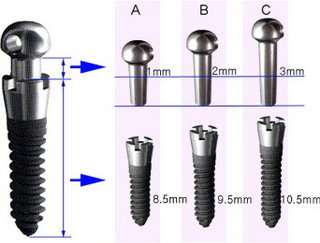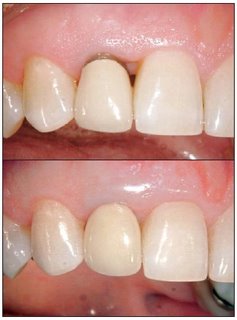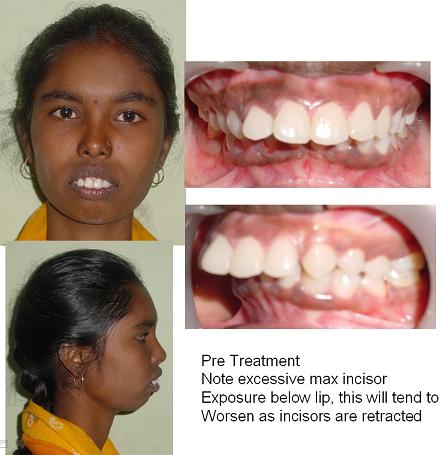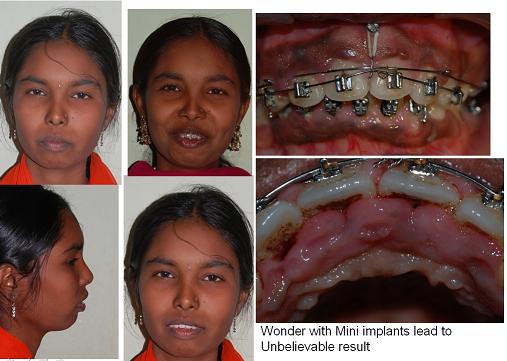Vaginal Flora vs Gingivitis
The vaginal microflora in relation to gingivitis
BMC Infectious Diseases, Jan 2009
Gingivitis has been linked to adverse pregnancy outcome (APO). Bacterial vaginosis (BV) has been associated with APO. We assessed if bacterial counts in bacterial vaginosis is associated with gingivitis suggesting a systemic infectious susceptibilty.
Gingivitis has been linked to adverse pregnancy outcome (APO). Bacterial vaginosis (BV) has been associated with APO. We assessed if bacterial counts in bacterial vaginosis is associated with gingivitis suggesting a systemic infectious susceptibilty.
Methods:Vaginal samples were collected from 180 women (mean age 29.4 years, SD +/- 6.8, range: 18 to 46), and at least six months after delivery, and assessed by semi-quantitative DNA-DNA checkerboard hybridization assay (74 bacterial species). BV was defined by Gram stain (Nugent criteria). Gingivitis was defined as bleeding on probing at >= 20% of tooth sites.
Results:A Nugent score of 0-3 (normal vaginal microflora) was found in 83 women (46.1%), and a score of >7 (bacterial vaginosis) in 49 women (27.2%). Gingivitis was diagnosed in 114 women (63.3%). Women with a diagnosis of BV were more likely to have gingivitis (p = 0.01). Independent of gingival conditions, vaginal bacterial counts were higher (p<0.001)> 1.0 x 10 to the 4 cells) and a diagnosis of gingivitis was 3.9 for P.bivia (95% CI 1.5-5.7, p <>
Conclusions:Higher vaginal bacterial counts can be found in women with BV and gingivitis in comparison to women with BV but not gingivitis. P.bivia and P.disiens may be of specific significance in a relationship between vaginal and gingival infections.
Clean the Apex optimally, thats a true professional service
Tapered instrument companies would like you to believe that most canals are 20-30 in apex, that is not the truth. Curious? want to read more- LINK 1 LINK 2

This graphic shows common sizes and range for 2500 canals done by highly experienced LSX users. If you place instrument from apex of an extracted tooth you will be surprised to see what size instrument can go to this unprepared apex.
Moreover only a non tapered instrument can show you what the apical size is before starting.
In many cases apical pulp may be vital in such cases even a novice will do a successful RCT, in infected cases if apex is properly cleaned with LSX you will never need to do apicoectomy. Also in profuse bleeding cases -go with LSX and it will cleanly excise the apical pulp and bleeding instantly stops. Order LSX now and experience endodontic revolution in your clinic.
Mini implants latest case
Here we bring you another example of what can be achieved routinely and effectively with use of micro implants. These are titanium implant screws of 1.3 mm dia and 8 mm long. Extremely simple to use and helps you treat cases that you normally refuse for fixed ortho. To see many more cases CLICK HERE, start using them in your CLINIC NOW.
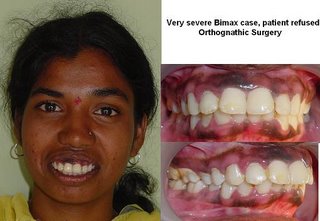
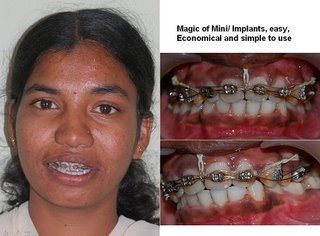
The interdental gingiva, a visible guide for placement of mini-implants
Orthod Craniofac Res 2009;12:20–24
Objectives – To determine whether the tip of the interdental gingiva can serve as a
visible guide for placement of mini-implants.
Computer tomography (CT) images from 15
males and 15 females (mean age 27 years, range: 23–35 years) were used to
evaluate the distance from the tip of the interdental gingiva to the alveolar crest from
the central incisor to the 1st molar. \
Results – There was no significant difference in the distance from the tip of
interdental gingiva to the alveolar crest between maxilla and mandible. The distance
between the tip of interdental gingiva and the alveolar crest at the central ⁄lateral
incisors was the shortest compared with that of other sites. There was also a
statistically significant difference between the male and female groups except for the
maxillary 2nd premolar ⁄1st molar interradicular site.
Conclusion – The tip of interdental gingiva appears a reasonable visual guide for
the placement of mini-implants for orthodontic anchorage. Ask for full paper to know ?mm
Christensen 'embarrassed' by U.S. dentistry
The granddad of U.S. dentistry is ashamed of his family. "What we do in America is embarrassing," Gordon Christensen, D.D.S., M.S., Ph.D., said at the ADA meeting in San Antonio recently.
With his Clinicians Report review, Scottsdale Center for Dentistry courses, frequent bylines in the Journal of the American Dental Association, and popular talks at dental meetings, Dr. Christensen may be the most influential U.S. dentist. So it means something when he deplores the state of the profession in his own country.
Dr. Christensen offered several unfavorable comparisons between dentistry in the U.S. and other countries during a panel discussion about controversies in dentistry, which he moderated at the ADA meeting. He also touched on such questions as mini-implants, cracked teeth, light-activated whitening, and articaine.
He mentioned his embarrassment in the context of choosing when a crown is appropriate. He said many U.S. dentists place porcelain fused to metal (PFM) crowns in cases in which he might recommend an onlay. email icdr@hotmail.com for full story
Coffee could aid in fight against oral cancer
A Japanese study has found that people who drink at least one cup of coffee a day appear to be at a lower risk for oral cancer compared to people who don't drink coffee (American Journal of Epidemiology, December 15, 2008, Vol. 168:12, pp. 1425-1432).
Researchers collected data from the population-based Miyagi Cohort Study that looked at people's dietary habits, including coffee consumption -- specifically, the frequency of consumption. Subjects were also asked about personal and family history of disease, physical status, drinking and smoking habits, occupational status, and educational status.
More than 30,000 subjects between the ages of 40 and 64 were followed over a 13-year period. A total of 157 cases of oral, pharyngeal, or esophageal cancer were recorded.
Researchers noted that people who drank more than one cup of coffee per day appeared to have half the risk of developing these cancers compared to those who did not drink coffee at all.
"We found a significant inverse association between coffee consumption and the combined incidence risk of oral, pharyngeal, and esophageal cancers for both men and women," the authors wrote.
This trend was consistent regardless of sex or the site of the cancers, and was even observed in high-risk populations such as smokers and drinkers.
Penile Fractures: More Than a Sex Myth on 'Grey's Anatomy'
ONLY MAN ARE ALLOWED TO CLICK HERE
Clean the Apex optimally, thats a true professional service
Tapered instrument companies would like you to believe that most canals are 20-30 in apex, that is not the truth. Curious? want to read more- LINK 1 LINK 2

This graphic shows common sizes and range for 2500 canals done by highly experienced LSX users. If you place instrument from apex of an extracted tooth you will be surprised to see what size instrument can go to this unprepared apex.
Moreover only a non tapered instrument can show you what the apical size is before starting.
In many cases apical pulp may be vital in such cases even a novice will do a successful RCT, in infected cases if apex is properly cleaned with LSX you will never need to do apicoectomy. Also in profuse bleeding cases -go with LSX and it will cleanly excise the apical pulp and bleeding instantly stops. Order LSX now and experience endodontic revolution in your clinic.
Mini implants latest case
Here we bring you another example of what can be achieved routinely and effectively with use of micro implants. These are titanium implant screws of 1.3 mm dia and 8 mm long. Extremely simple to use and helps you treat cases that you normally refuse for fixed ortho. To see many more cases CLICK HERE, start using them in your CLINIC NOW.


The interdental gingiva, a visible guide for placement of mini-implants
Orthod Craniofac Res 2009;12:20–24
Objectives – To determine whether the tip of the interdental gingiva can serve as a
visible guide for placement of mini-implants.
Computer tomography (CT) images from 15
males and 15 females (mean age 27 years, range: 23–35 years) were used to
evaluate the distance from the tip of the interdental gingiva to the alveolar crest from
the central incisor to the 1st molar. \
Results – There was no significant difference in the distance from the tip of
interdental gingiva to the alveolar crest between maxilla and mandible. The distance
between the tip of interdental gingiva and the alveolar crest at the central ⁄lateral
incisors was the shortest compared with that of other sites. There was also a
statistically significant difference between the male and female groups except for the
maxillary 2nd premolar ⁄1st molar interradicular site.
Conclusion – The tip of interdental gingiva appears a reasonable visual guide for
the placement of mini-implants for orthodontic anchorage. Ask for full paper to know ?mm
Christensen 'embarrassed' by U.S. dentistry
The granddad of U.S. dentistry is ashamed of his family. "What we do in America is embarrassing," Gordon Christensen, D.D.S., M.S., Ph.D., said at the ADA meeting in San Antonio recently.
With his Clinicians Report review, Scottsdale Center for Dentistry courses, frequent bylines in the Journal of the American Dental Association, and popular talks at dental meetings, Dr. Christensen may be the most influential U.S. dentist. So it means something when he deplores the state of the profession in his own country.
Dr. Christensen offered several unfavorable comparisons between dentistry in the U.S. and other countries during a panel discussion about controversies in dentistry, which he moderated at the ADA meeting. He also touched on such questions as mini-implants, cracked teeth, light-activated whitening, and articaine.
He mentioned his embarrassment in the context of choosing when a crown is appropriate. He said many U.S. dentists place porcelain fused to metal (PFM) crowns in cases in which he might recommend an onlay. email icdr@hotmail.com for full story
Coffee could aid in fight against oral cancer
A Japanese study has found that people who drink at least one cup of coffee a day appear to be at a lower risk for oral cancer compared to people who don't drink coffee (American Journal of Epidemiology, December 15, 2008, Vol. 168:12, pp. 1425-1432).
Researchers collected data from the population-based Miyagi Cohort Study that looked at people's dietary habits, including coffee consumption -- specifically, the frequency of consumption. Subjects were also asked about personal and family history of disease, physical status, drinking and smoking habits, occupational status, and educational status.
More than 30,000 subjects between the ages of 40 and 64 were followed over a 13-year period. A total of 157 cases of oral, pharyngeal, or esophageal cancer were recorded.
Researchers noted that people who drank more than one cup of coffee per day appeared to have half the risk of developing these cancers compared to those who did not drink coffee at all.
"We found a significant inverse association between coffee consumption and the combined incidence risk of oral, pharyngeal, and esophageal cancers for both men and women," the authors wrote.
This trend was consistent regardless of sex or the site of the cancers, and was even observed in high-risk populations such as smokers and drinkers.
Penile Fractures: More Than a Sex Myth on 'Grey's Anatomy'
ONLY MAN ARE ALLOWED TO CLICK HERE

